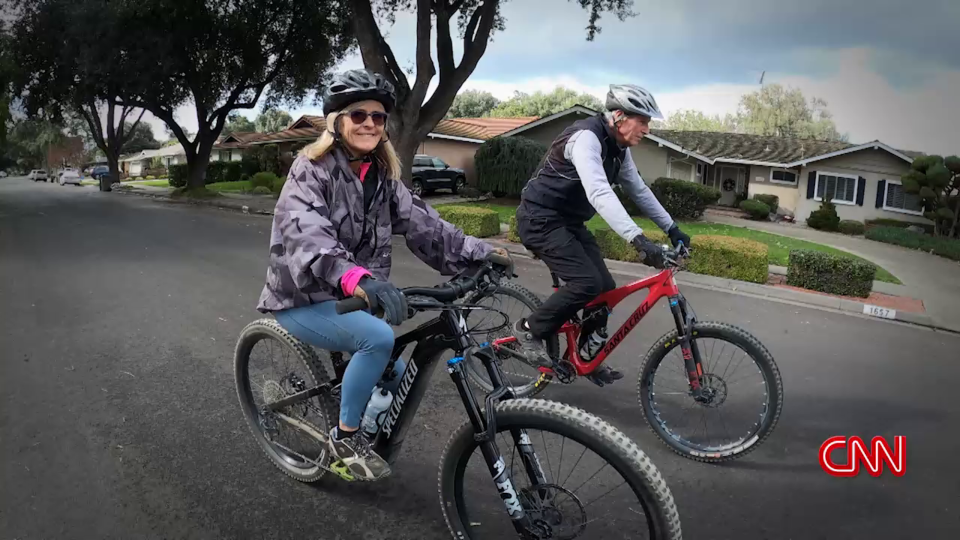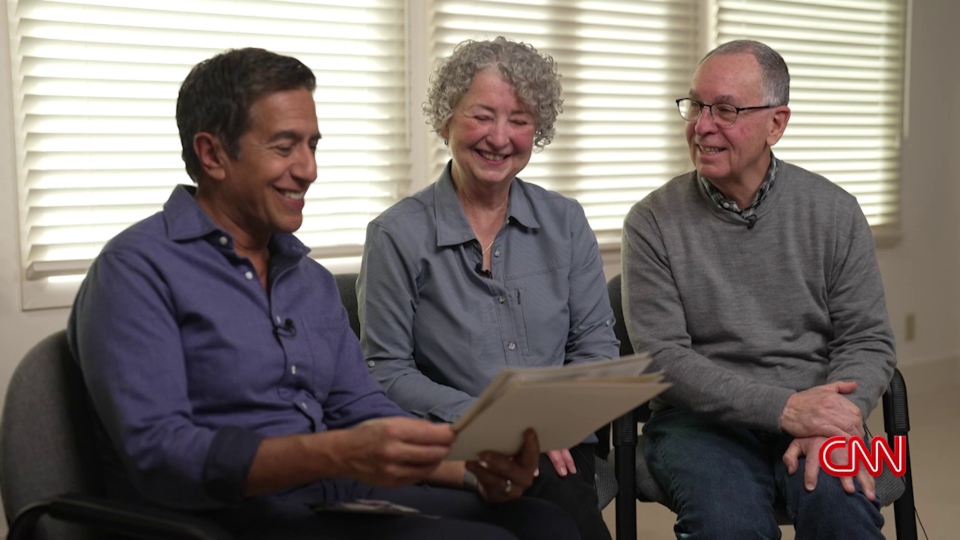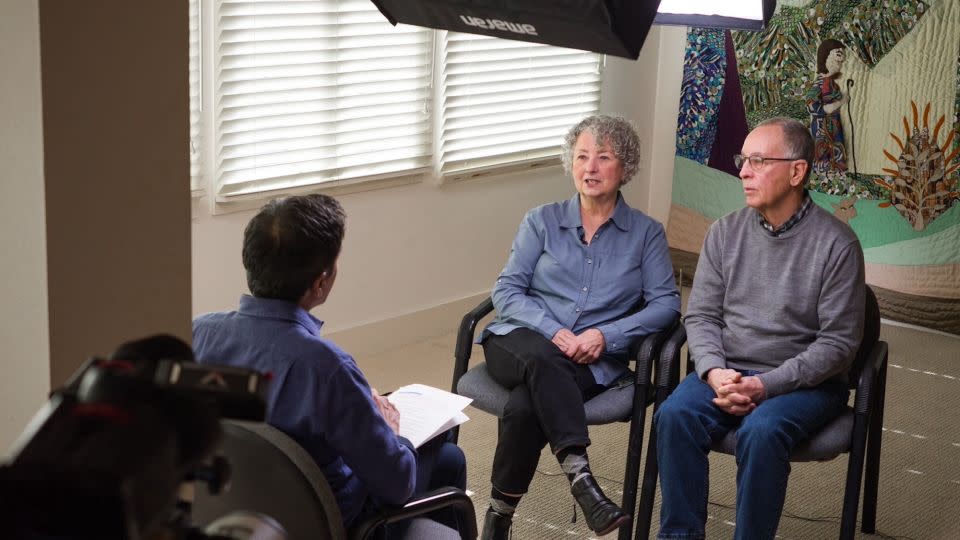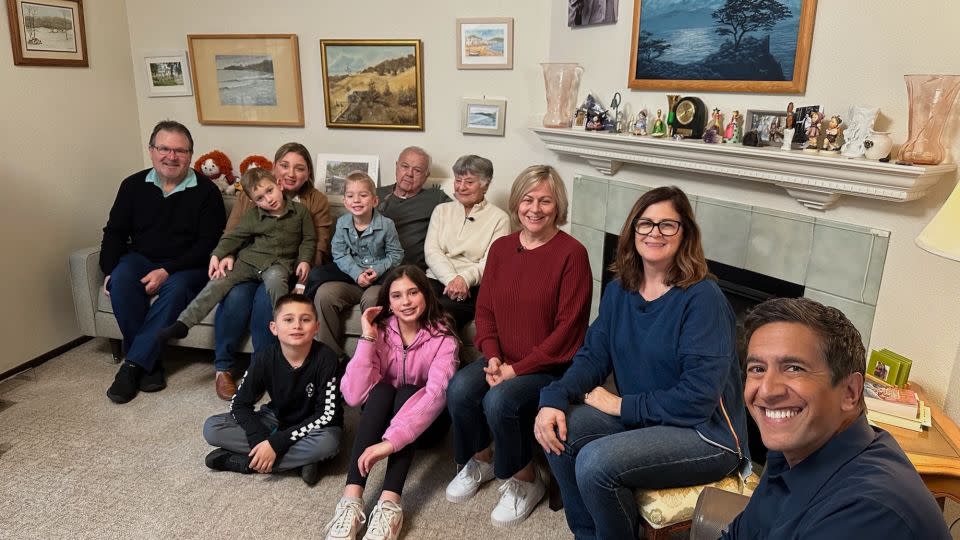‘A study to give us hope’: Lifestyle changes improve Alzheimer’s symptoms for some
Editor’s note: CNN Chief Medical Correspondent Dr. Sanjay Gupta’s documentary“The Last Alzheimer’s Patient” streams June 18 on MAX as part of “The Whole Story With Anderson Cooper.”
Looking back, Tammy Maida, 67, said things started to change in her late 50s. At first, she would lose track of her belongings: her keys multiple times a day, a ring, eyeglasses, her purse.
She would drive to the grocery store in her hometown of San Jose, California, and forget where she parked the car. At home, she couldn’t remember where she had put the groceries. Her husband, Paul, would sometimes find them in the garage.

A lifelong, avid reader, Maida stopped picking up books because she couldn’t remember the last chapter she had read or the major characters.
“I honestly thought I was losing my mind, and the fear of losing my mind was frightening,” she told CNN Chief Medical Correspondent Dr. Sanjay Gupta for the CNN documentary “The Last Alzheimer’s Patient.”
Today, Maida is back to devouring short novels and helping with the family finances.
Another patient, Mike Carver, 71, was diagnosed with early-onset Alzheimer’s at age 64 while working as a business executive. Doctors told him to put his affairs in order with little hope for the future. Carver eventually learned that he was a carrier of both copies of the APOE4 gene, which carries the highest-known genetic risk for Alzheimer’s.
Now, however, Carver is back to reconciling the family finances and keeping track of investments.
“It’s kind of like doing a happy dance,” he said with a laugh. “It was kind of hard saying that part of me was just gone. And so a lot of self-worth has come back.”
How did Maida and Carver gain back what dementia had stolen from them? By participating in what researchers call the first randomized controlled clinical trial to use lifestyle interventions and show cognitive improvement in people with mild cognitive impairment or early dementia due to Alzheimer’s disease.

‘A study to give us hope’
The study, published Friday in the journal Alzheimer’s Research and Therapy, was small, with only two dozen people receiving treatment and a similar number serving as controls over a short, five-month period. Not everyone showed improvement. Still, for some participants and their families, there were remarkable changes.
The thinking skills of a majority of people in the intervention group stayed the same, a boon since most in the control group declined. Ten people saw their cognition actually improve, while a blood test found levels of amyloid, a hallmark of Alzheimer’s disease, were retreating, said lead study author Dr. Dean Ornish, a clinical professor of medicine at the University of California, San Francisco.
“This is a study to give us hope,” said journalist and former California first lady Maria Shriver, founder of the Women’s Alzheimer’s Movement at Cleveland Clinic in Ohio, which provided early seed funding for the new research.
“This study finally gives us scientific data to support what many of us in this field have believed instinctively for years, that lifestyle interventions may determine the trajectory of people’s Alzheimer’s journeys,” Shriver said in a statement.
Because the clinical trial was only five months long, the results were “astounding,” said co-senior study author Rudy Tanzi, an Alzheimer’s researcher and professor of neurology at Harvard Medical School in Boston.
“If you picture a brain full of damage as a sink full of water, when you just turn off the tap, it takes a long time for that sink to slowly drain, right?” said Tanzi, director of the McCance Center for Brain Health at Massachusetts General Hospital in Boston.
“If you want the amyloid to go down in 20 weeks, as we found on one blood test, you’re going to need a Roto-Rooter.”
That’s exactly what the study did — provide people with a carefully constructed, multipart, intensive lifestyle intervention that targets multiple contributors to cognitive decline. And those who put in the most effort saw the best results.
“There was a statistically significant dose-response relationship between the degree of adherence to our lifestyle changes and the degree of improvement we saw on measures of cognition,” said Ornish, creator of the Ornish diet and lifestyle medicine program, founder and president of the nonprofit Preventive Medicine Research Institute and coauthor of “Undo It!: How Simple Lifestyle Changes Can Reverse Most Chronic Diseases.”

“I would describe this as a really positive, small pilot study, a starting point for additional research,” said Dr. Suzanne Schindler, an associate professor of neurology at Washington University School of Medicine in St. Louis.
“I wish we could do a program like this for everyone, not just people with mild cognitive impairment or early stage Alzheimer’s,” said Schindler, who was not involved in the study.
‘Eat well, move more, stress less and love more’
The lifestyle intervention Ornish created — “eat well, move more, stress less and love more” — has been tested before. In 1990, Ornish showed for the first time in a randomized clinical trial that coronary artery disease could often be reversed with nothing more than diet, exercise, stress reduction and social support.
Since then, research has shown the same four-part program can lower blood sugars and heart disease risk in patients with diabetes, reduce prostate cancer cell growth, improve depression and reduce “bad cholesterol.”
“How is it that these same four lifestyle changes stop, and often reverse, the progression of such a wide spectrum of the most common and costly chronic diseases?” Ornish asked.
“It’s because they all share many of the same underlying biological mechanisms: chronic inflammation, oxidative stress, changes in the microbiome, changes in gene expression, changes in immune function and so on,” he said.
“And the lifestyle choices we make every day — what we eat, how we respond to stress, how much exercise we get, how much love and social support we have — can activate or downregulate these different mechanisms.”
Taking care of the heart and the brain
Since what’s good for the heart is good for the brain, Ornish asked, why couldn’t this intervention also work on early Alzheimer’s or other forms of dementia?
“If we found patients didn’t improve at all, that would be disappointing but an important finding — people need to know that,” Ornish said. “But if we found that we could slow, stop or even reverse the progression of Alzheimer’s disease, that would be an important finding as well.”
To find out, Ornish and professors from other leading academic centers began recruiting patients into a new study. Covid-19 hit, which stalled progress until the team realized it could offer the intervention via video conference calls.
“That was a game changer because before you had to live near a hospital or clinic that we trained in our program, and most people don’t,” Ornish said. “Now you can live anywhere, even a food desert or rural area.”
Fifty-one people were selected for the study, then randomized into two groups: One group would consume a vegan diet, do daily aerobic exercise, practice stress reduction and engage in online support groups for 20 weeks, while the control group would not.
A nutritionist held hour-long video classes on diet, while a therapist led equally lengthy group sessions three times a week in which participants shared their feelings and received support.
Each day a fitness instructor led online strength training exercises and encouraged 30-minute daily walks. Meditation, deep breathing, yoga and other ways to reduce stress took up another hour every day. The program also encouraged participants to prioritize good quality sleep.
Supplements were provided to everyone in the intervention group. They took a daily multivitamin, omega-3 fatty acids with curcumin, coenzyme Q10, vitamin C and B12, magnesium, a probiotic and Lion’s mane mushroom (Hericium erinaceus).
To be sure the vegan diet was followed, all meals and snacks for both the participant and spouse were delivered to their homes. Calories were unrestricted, but protein and total fat were about 18% of the daily caloric intake — experts say the average American eats twice the amount of protein they need and obtains 36% of daily calories from total fat.
Complex carbs found in whole grains, vegetables, fruits, tofu, nuts and seeds made up most of the diet. Sugar, alcohol and refined carbs found in processed and ultraprocessed foods were taboo.
“A minimally processed diet is key,” said Tanzi, who tests potential treatments for dementia on tiny organoids composed of human brain cells that develop signs of Alzheimer’s.
“The gut microbiome loves all the fiber from the whole grains, fruits and vegetables,” Tanzi said. “My lab has shown in animals that a happy gut can trigger metabolites to the brain, which induce microglial cells to eat more of the amyloid in the brain.”
Microglial cells are the brain’s housekeepers, responsible for tidying up synapses, taking out cellular trash and gobbling up nasties such as amyloid. They do most of their work at night during key stages of sleep.
But when neurons die due to injury, age or a disease such as Alzheimer’s, microglia become sidetracked, turning into killers to fend off whatever seems to be damaging the brain, Tanzi said. Doing so can unleash a cytokine storm, ramping up inflammation and causing further brain injury.
Lifestyle changes can help microglia get back on track, Tanzi said. Besides a high-fiber diet, aerobic exercise and plenty of good quality sleep also encourage microglial cells and other amyloid-clearing enzymes to do their jobs.
“Exercise and sleep induce clearance of amyloid in different ways than the gut microbiome,” Tanzi said. “Combining them is a powerful tool.”
In fact, microbiome tests of the study participants found two of the organisms that increase the risk of Alzheimer’s went down in the intervention group and up in the control group, Ornish said.
“At the same time, microorganisms believed to be protective against Alzheimer’s went up in the intervention group and down in the control group,” he added.
Improvement for some but not all
Five months into the program, the rest of the results were in. For some, such as Mike Carver and Tammy Maida, the program was life-changing.
In addition to an improvement in his cognition, Carver and his wife, Pat, lost weight and reduced their cholesterol numbers and resting heart rates. Mike’s PSA levels, a test for prostate cancer, looked better than ever before.

Maida is sleeping better and back to accomplishing the tasks she thought she had to give up due to Alzheimer’s: doing laundry, cooking, voraciously reading books, keeping track of household finances and small business bookkeeping.
“The cloud of the Alzheimer’s diagnosis slowly started to lift,” she told CNN’s Gupta. “Honestly, I am more me than I had been for the years prior to starting Dr. Ornish’s program.”
However, not everyone in the intervention improved. Two people dropped out — one couldn’t give up McDonald’s on the way home from his daily walks.
“It was only a 20-week intervention period with a small sample size of just 24 people,” said John Morris, distinguished professor of neurology and codirector of the Knight Alzheimer’s Disease Research Center at Washington University School of Medicine.
“Only 10 out of 24 people in the intervention group seemed to improve and that meant 14 did not,” said Morris, who was not involved in the study. “Overall, it’s interesting, but it would need to be a larger study, with a more representative sample and a longer treatment period to draw any definite conclusions.”
For people who did the intervention, a blood test called plasma Aβ42/40 showed an “extremely” significant improvement, the study found. The test measures the level of amyloid in the blood, a sign that the microglia in the brain are doing their job. Tests that measure amyloid in different ways did not show improvement, however.
“Unfortunately, not all the biomarkers were showing consistent effects,” said Washington University’s Schindler, who specializes in blood biomarkers.
There was no significant change in a test for amyloid called p-tau 181, considered to be a superior measure of Alzheimer’s risk, Schindler said. Nor was there any change in glial fibrillary acidic protein, or GFAP, another blood biomarker that seems to correlate reasonably well with Alzheimer’s disease.
“If one of these markers improves, you typically see all of them improve, so the fact they did not makes me wonder whether this effect is real,” she said. “If they were to repeat the study with a much larger population for a longer period of time, perhaps more change could be seen.”
Need for empowerment
One of the earliest patients recruited to the study was Cici Zerbe, now in her mid-80s. Six years ago, a neurologist diagnosed her with mild cognitive impairment and dementia due to Alzheimer’s. She knew what that meant.
“My grandmother, she would sit forever and just twiddle her thumbs and stare into space and wouldn’t talk too much,” Zerbe told Gupta, who tracked her progress for five years in the documentary.
“Her mother, they finally put her in a home because her father couldn’t take care of her,” said Zerbe’s husband, John. “My greatest fear was she would end up like her mother and grandmother, where I couldn’t take care of her.”
A lifelong runner, retired educator and matriarch of a large family, Zerbe joined Ornish’s study in 2019. Nearly five years later, Zerbe and her husband, who live in Novato, California, are still doing the program, and believe the intervention has turned her life around.
“It’s really helped. I think it’s slowed it down,” her daughter Alicia Manzoni told Gupta.
“I think she’s doing very well,” her husband added. “I was afraid by this time she would be in a home or something.”
After all, it’s the improvement in daily life, not blood or cognitive tests, that is most meaningful to a person with Alzheimer’s and their family, said Washington University’s Morris.

“What matters to the patient in the family is whether they’re able to do the things they normally do,” Morris said. “If they couldn’t read and now, they can read, that’s great. That’s an outstanding achievement.”
For Ornish, who has watched members of his family die from Alzheimer’s, the study’s results are important for one key reason — hope.
“So often when people get a diagnosis of dementia or Alzheimer’s, they are told by their doctors that there is no future, ‘It’s only going to get worse, get your affairs in order.’ That’s horrible news and is almost self-fulfilling,” Ornish said.
“I’m not about false hope, and I’m not saying that everyone will get better,” he added. “I’m here to empower people with the knowledge that if you do change, there is a reasonably good chance that you may slow the progression of the disease and often improve it.”
For more CNN news and newsletters create an account at CNN.com




